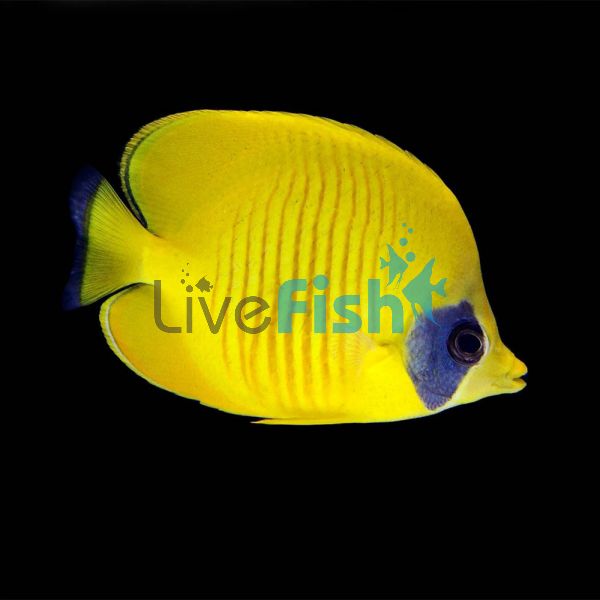Red Lined Butterflyfish MED
This is a well-known and popular butterflyfish. With its large size, vibrant colours, and graceful swimming movements, it is an amazing species. A true treasure for any aquarium enthusiast.
Adults can reach impressive lengths of about 12 inches (30 cm) in the wild, though 9 inches is more common (23 cm). Its colour pattern is also eye-catching. The bright yellow body and delicate red striping contrast nicely with the bold dark bluish mask.
The Red-line Butterflyfish is one of the most straightforward butterflyfish to manage in captivity. They don’t have difficult to maintain water requirements and can eat a range of foods. It is not recommended to keep them in reef aquariums since it will snack on the polyps of some stony and soft coral species.
Cuvier described the Red lined Butterflyfish in 1831 after it was discovered in the Red Sea. This species was long thought to be restricted to the Red Sea. Recent diving observations have revealed that in fact it also occurs in the Gulf of Aden and southern Oman.
Tank Recommendations for Red Lined Butterflyfish
This fish requires a large aquarium with plenty of hiding spots as well as open swimming areas. A 100-gallon or (379 litre) tank is the smallest recommended size for a single fish. Even for adults, the tank should be well-decorated with rocks and corals, with plenty of hiding places. This fish is a coral eater, snatching polyps from hard stony coral species. As a result, it is not suitable for coral-rich reef aquariums.
This fish does not require any special care or strategy to keep it alive in the aquarium, and it will grow into a resilient fish. Although it is not a fast swimmer, it swims freely and spends much of its time in open water and going in and out of crevices. Normal water changes of 10% biweekly or 20% monthly are sufficient rather than frequent water changes. Water changes that occur suddenly and in large amounts might be problematic.
Suitable Tank Buddies
This is not an aggressive fish and can thrive in a fish-only community tank with other species that are not overly territorial or aggressive. It can be territorial with its species as well as similar looking Butterflyfish, so it is best kept alone. In a larger aquarium, however, pairs or small groups can be kept.
Usually Compatible
As this species is not aggressive, choosing tank mates that are not territorial or aggressive is recommended. It does best if kept alone because it can be territorial towards its own species and related Butterflyfish. In a bigger tank, however, pairs or small groups can be kept. It can be housed with Angelfish from the Pomacanthus and Holacanthus genera, which are larger and more territorial. Centropyge, as well as Angelfish from the genera Apolemichthys, Genicanthus, Chaetodontoplus, and Pygoplites, are all usually compatible and make good tank mates.
Sometime Compatible
Although it thrives in a coral-rich environment, it will nip some hard and soft coral species. Filefish, Triggerfish and Crustaceans are usually compatible with Red-line Butterflyfish providing the tank is large enough and there are places for hiding.
Rarely Compatible
Small but aggressive fish like Dottybacks are rarely compatible with Red-line Butterflyfish along with larger fish like Bass or Scorpionfish and of course Sharks that will try to eat them.
Feeding your Red Lined Butterflyfish
In the wild Red Lined Butterflyfish feed on live coral polyps, sessile invertebrates, and zooplankton. Meaty foods, dried flakes, shrimps, and pellet food should all be offered in the aquarium and then adjust their diet as required. Nori (Asakusa-nori) from Japan is usually readily accepted and provides many important nutrients. When your Butterflyfish is first introduced to the tank offer a variety of foods pretty often. It will become a hardy fish once properly acclimated. Feed it at least twice a day, and three to four times a day is recommended if it's a young juvenile.
| Scientific Name | Chaetodon semilarvatus |
|---|---|
| Care Level | Easy |
| Common Names | Red-lined Butterflyfish, Blue Mask Butterflyfish, Bluecheek Butterflyfish, Addis Butterflyfish, Golden Butterflyfish, Masked Butterflyfish |
| Diet | Omnivore |
| Fish Family | Chaetodontidae |
| Lifespan (years) | 7 |
| Max. Length (cm) | 30 |
| Min. Tank Volume (l) | 379 |
| Origin | The Red Sea, Gulf of Aden and southern Oman |
| Reef Safe | No |
| Sociability | Peaceful |
| Venomous | No |
| Water Conditions | (23.9 to 26.1° C) 1.020-1.025 SG ph: 8.1-8.4 |




